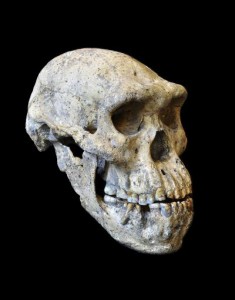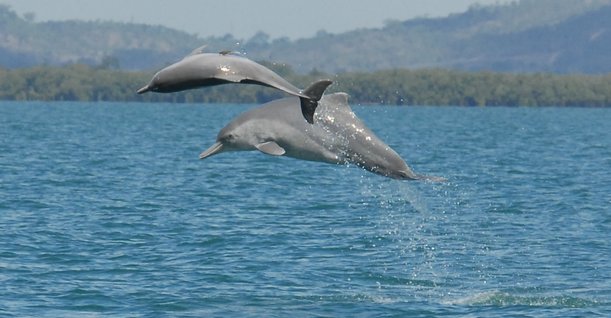What Is a Species? Insight From Dolphins and Humans
More than 70 definitions exist for what makes a species—each is applied to a different group of organisms & uses different methods for determining a label
/https://tf-cmsv2-smithsonianmag-media.s3.amazonaws.com/filer/20131106100200rsz_rsz_molecol_cover_aus.jpg)
New species of insects, worms and other creepy-crawlers are announced on a monthly basis. Similarly, just last week, two new humpback dolphin species splashed into the headlines. And in October, news broke that early humans may have included fewer species than previously thought. This forces the question: what does it take to be a distinct species?
More than 70 official species definitions exist, of which 48 are widely accepted and used by scientists. And there’s no hard rule that scientists must stick to just one definition; some apply a handful of species definitions when approaching the topic. “I personally go to my lab every day and use five species definitions to conduct research,” says Sergios-Orestis Kolokotronis, a molecular ecologist at Fordham University, and co-author of the new dolphin study, published in Molecular Ecology. “And I sleep just fine amidst this uncertainty.”
Species definitions oftentimes do not translate from one organism to another. Dolphins may become isolated by distance and behavior that prevents them from reproducing, but in other cases–such as bacteria, which reproduce asexually–these distinguishing markers do not apply. Thus, the definition of what constitutes a species varies depending on whether scientists are studying dolphins, monkeys, insects, jellyfish, plants, fungi, bacteria, viruses or other organisms, Kolokotronis explains. And likewise, methods for investigating those species also vary. “Whoever figures out THE unifying species definition across the Domains of Life gets the Crafoord Prize!” Kolokotronis jokes.
In the case of the four dolphin species, each occupy different sections of ocean around the world, including in the Atlantic off West Africa (Sousa teuszii), in the central to western Indo-Pacific (Sousa plumbea), in the eastern Indian and western Pacific (Sousa chinensis) and in northern Australia (researchers are in the process of working on a name for that one–Sousa bazinga, anyone?).
While the humpback dolphins look quite similar, their genetics tells a different story. Researchers collected 235 tissue samples and 180 skulls throughout the animals’ distribution, representing the biggest dataset assembled to date for the animals. The team analyzed mitochondrial and nuclear DNA from the tissue, which revealed significant variations between those four populations. They also compared the skulls for morphological differences.
Although the line between species, sub-species and populations is a blurry one, in this case, the researchers are confident that the four dolphins are divergent enough to warrant the “species” title. The mitochondrial DNA turned up genetic signatures distinct enough to signal a separate species, and likewise, differences in the dolphins skulls supported this divergence. Although the nuclear DNA provided a slightly more confounding picture, it still clearly showed differences between the four species.
“We can confidently say that such strong divergence means these populations are demographically and evolutionarily isolated,” says Martin Mendez, a molecular ecologist at the American Museum of Natural History and lead author of the dolphin paper. “The key is that all the evidence–mitochondrial DNA, nuclear DNA and morphology–exhibited concordant patterns of distinct units,” he continues, which are “usually a must for species proposals.”

Name me! Australian humpback dolphins eagerly await their very own scientific name. Photo by Mendez et al., Molecular Ecology
The genetic data the team collected does not have enough resolution to reveal how long ago the humpback dolphins diverged, and the team has yet to examine the drivers that fueled those speciation events. But Mendez and his colleagues have found that, in some dolphin populations, environmental factors such as currents and temperature play a role in separating populations and encouraging speciation. Different behaviors can help reinforce that separation, too. Most likely, however, geographic isolation plays a significant role in this case. “For populations living a couple hundred kilometers from one another, it’s perfectly possible for them to meet,” Mendez says. “But the distance from Africa to Australia is so great, it’s difficult to imagine those populations would ever be linked.”
Dolphins, Mendez and his colleagues are finding, evolve relatively quickly once isolated from parent populations. New cryptic–or hidden–species have similarly turned up in waters near South America. There may very well be other species of dolphins–or any type of animal, in fact–lurking undetected within an already-discovered species. ”This really applies to most taxa,” Mendez says. Across the board, “we’re adding many more species by looking at genetic data.”
While cryptic species almost certainly await discovery and will increase the head-counts of some organisms, in the case of ancient human ancestors, on the other hand, researchers now suspect that we’ve been too quick to pull the species card. An extremely well-preserved, approximately 1.8 million year-old Homo erectus skull discovered in Georgia alerted scientists to the potential revision. The skull’s odd proportions–large, but with a small brain case–prompted researchers to analyze variation between modern human and chimpanzee skulls, and compare those variations with other known human ancestor species. As the Guardian reports:
They concluded that the variation among them was no greater than that seen at Dmanisi. Rather than being separate species, the human ancestors found in Africa from the same period may simply be normal variants of H erectus.
If the scientists are right, it would trim the base of the human evolutionary tree and spell the end for names such as H rudolfensis, H gautengensis, H ergaster and possibly H habilis.

The mysterious and controversial Dmanisi skull. Photo by Guram Bumbiashvili, Georgian National Museum
Ancient humans, of course, are no longer around for us to study their behaviors and mating tendencies, so anatomy has to do. For now, researchers are calling for more specimens to determine where that line will fall.
The line distinguishing two species may be a fuzzy one, but in the case of the dolphins, it is a big deal in terms of conservation. Australia, for example, is planning to design protective legislation for its new dolphin species, and Mendez hopes other countries will do the same.
Nonetheless, pondering the speciation of humans in dolphins in light of these two findings raises lots of questions: Are we fractally subdividing genetic information and brain cavity size to group and regroup organisms, or is there vast genetic diversity in even familiar species that we’ve yet to uncover? What does it mean for a species to gain or lose members of its family tree? The world and its organisms await more research.

Two members of the newly identified Australian dolphin species. Photo by Mendez et. al., Molecular Ecology
/https://tf-cmsv2-smithsonianmag-media.s3.amazonaws.com/accounts/headshot/Rachel-Nuwer-240.jpg)
/https://tf-cmsv2-smithsonianmag-media.s3.amazonaws.com/accounts/headshot/Rachel-Nuwer-240.jpg)